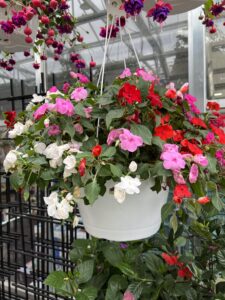AMES, Iowa — As Mother’s Day approaches, garden centers are filled with hanging baskets. These colorful containers make great gifts. In this article, horticulturists with Iowa State University Extension and Outreach explain special care considerations for hanging baskets.What should I look for when purchasing a hanging basket?
When buying hanging baskets, look for healthy plants that are well-balanced in the container. Remember that hanging baskets can get quite overgrown by mid-summer, so selecting baskets that still have some space for growth is beneficial and can reduce maintenance later in the season.
Consider the container carefully. Hanging baskets can require a lot of maintenance, especially watering. The classic hanging basket is a metal basket or frame lined with coconut fiber, moss, burlap, or compressed fiber. These baskets are attractive but often dry out quickly because water can evaporate from the top and sides. Containers made from plastic are not porous, so they do not dry out as quickly. Many also contain small reservoirs that can help keep the soil well-hydrated. Larger and deeper containers will not dry out as quickly but will be heavier. Be sure to select a hanging basket that can be supported by the hook you plan to hang it from when fully hydrated.How often should I water plants in hanging baskets?
Plants in hanging baskets need to be watered frequently (especially in summer). Potting mixes are light, well-drained, and dry out quickly. Plus, hanging baskets typically contain several plants. In general, water plants in hanging baskets when the soil surface becomes dry to the touch. On hot, sunny days, it may be necessary to water once a day.
When watering hanging baskets, be sure to apply water until water begins to flow out the bottom of the container. This ensures that the entire soil ball has been moistened. Do not let the potting mix dry out completely. Plants will wilt, and it is more difficult to re-moisten the potting mix when it has dried out completely.
If the potting mix becomes extremely dry, it will pull away from the sides of the container. When you water from above, most of the water will flow between the soil ball and container and run out the drainage holes at the bottom. When this happens, place the basket in a tub of water for one or two hours. This forces water to be absorbed slowly from the bottom of the container. Do not keep the basket in the tub of water for more than two hours, as this may result in root rot problems.What should I do when the plants in my hanging basket get leggy?
Many hanging baskets will become quite large by mid-summer. Pruning back trailing plants by one-third to one-half can help promote fresh new growth that will be more attractive and produce more flowers for the remainder of the growing season. After pruning, provide fertilization. Use all-purpose fertilizers with a 1:2:1 ratio of nitrogen, phosphorus and potassium. Fertilizers that are high in nitrogen should be avoided, as they cause excessive vegetative growth at the expense of flowers.What plant species are best suited for hanging baskets?
Many different types of annuals and tropical plants are well suited for hanging baskets, especially those with a trailing growth habit. In general, plants well-adapted to drier soil conditions perform better in hanging baskets, especially those in full sun or windy locations. However, nearly any annual can be grown in a hanging basket if provided its ideal amount of light and kept consistently watered.
For full sun locations consider petunia (Petunia x hybrida), million bells (Calibrachoa x hybrida), ivy geranium (Pelargonium peltatum), geranium (Pelargonium x hortorum), nasturtiums (Tropaeolum majus), verbena (Verbena x hybrida), chenille plant (Acalypha hispida), moss rose (Portulaca grandiflora), fanflower (Scaevola aemula), silver falls dichondra (Dichondra argentea ‘Silver Falls’), licorice vine (Helichrysum petiolare), Diamond Frost® euphorbia (Euphorbia ‘Inneuphdia’), and asparagus and foxtail ferns (Asparagus).
For shade or part-shade locations, select species such as fuchsia (Fuchsia), impatiens and New Guinea impatiens (Impatiens), Boston fern (Nephrolepis exaltata), rabbit’s foot fern (Davallia fejeensis), English ivy (Hedera helix), bacopa (Bacopa sutera), pansy (Viola x wittrockiana) and any begonia (Begonia) including angel wing, rex, wax and tuberous.
Any compact variety of vegetables that grows well in a container can also be grown in hanging baskets. Edibles in hanging baskets need full sun and consistent moisture. Edible plants that are particularly well-suited for hanging baskets include strawberry (day-neutral or everbearing varieties), compact cultivars of tomato, compact cultivars of chili peppers, lettuce, thyme, oregano and mint.
Many succulents do well in hanging baskets, especially in hot locations or in smaller containers that are more likely to dry out. While many succulents can do well in full sun, most prefer part sun locations outdoors. Nearly any succulent could be used in a hanging basket, including burro’s tail (Sedum morganinum), stonecrop (Sedum), fishbone, ric rac, and orchid cactus (Epiphyllum syn: Disocactus) and holiday cactus (Schlumbergera).

Hanging basket with Impatiens

(contributed press release, ISUANR)










